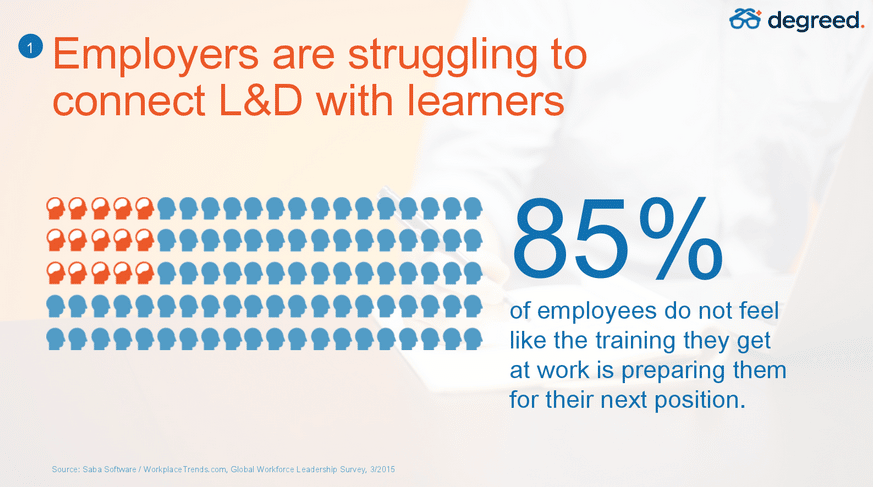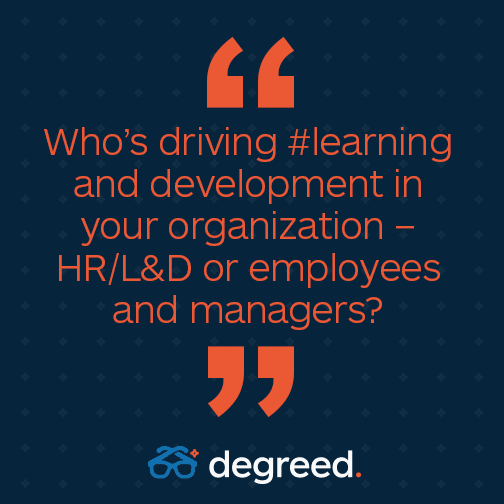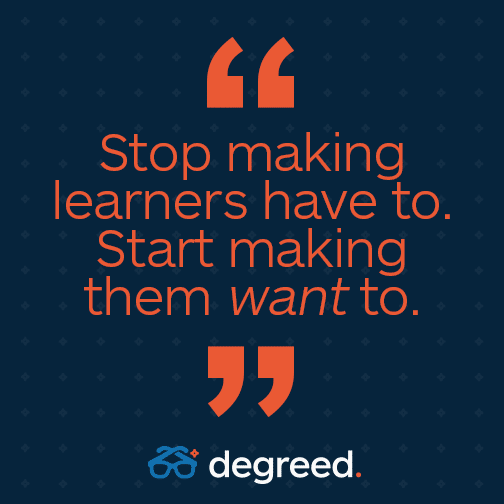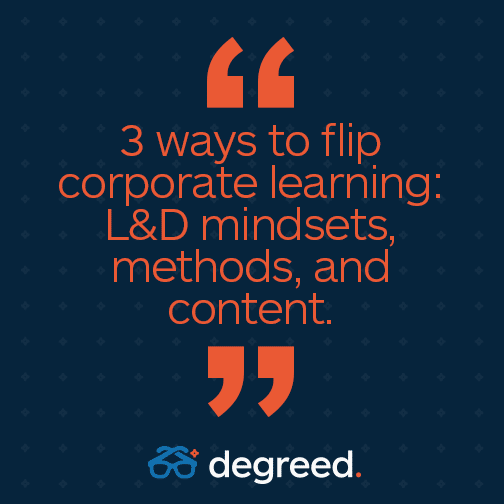When it comes to Learning and Development approaches, it’s time to put the Learner first. Here’s a quick recap if you missed our May Webinar, catch up and tweet us any questions or comments @degreed.
Let’s start with why. You may notice some problems or feel a need for change within your processes. Here’s why we think it’s time to rethink L&D priorities:
First, L&D teams are struggling to form connections with their learners. Here are the numbers: 60% of workers think the skills they have now will not be what they need in 3 years. Learning and development are clearly essential, however, 85% of employees do not feel like the training they get at work is preparing them for their next position.
Second, the landscape of work has changed- and most current L&D systems can’t keep up with what people need to know or how people like to learn and search out information. Skills are quickly changing, more jobs require primarily creative thinking and problem solving skills- not just the ability to follow directions. What learners need to know can change in a matter of weeks, but it takes 5-12 weeks to create just one hour of interactive learning.
Learners get work-related information from articles, videos, and books weekly while traditional L&D’s are still doing mostly formal training- classroom and instructor style.
These disconnects all result in learners taking control of their own learning. Conventional L&D methods aren’t working for today’s learners- it’s time to try new approaches.
Here are 4 helpful ways to make the shift in mindset and provide learners with the information and tools they need.
1. Start putting learners first. This is a big mindshift, it means to put learners not just at the center, but at the beginning. Where they learn from others and from experiences more than they do in formal training. When you acknowledge there’s a problem in the current process, you can start working towards a solution- and investing resources differently.
2. Stop trying to command and control- start empowering. After making the shift to put learners at the beginning you’ll start to answer these questions differently about the role of the L&D department:
-Who’s responsible for driving L&D activity – HR and L&D or employees and their managers?
– When and where does learning happen – on a schedule at work or anytime, anywhere?
– What and why do people learn – for operational efficiency and compliance or to build strategic capabilities and performance?
– How do they learn – mainly through formal classes and online courses or in the flow of their work?
3. Stop making learning one-size-fits-all, and start offering choices.
Give learners choices on the types of content they can consume. Create different options- think short videos and quizzes, 5-minute tutorials on management skills, animated role plays, etc.
4. Stop Making Learners Have To- Start Making Them Want To.
Focus more effort on things learners care about-leadership, soft-skills and sales. These are also the things that enable strategy and drive business performance. This doesn’t mean you need to stop operational and compliance stuff, it just means you need to make it a point to do them smarter.
Now that you’ve accessed the problem and had the mind-shift, it’s time to talk rewiring and getting to work.
The hard part: Doing the work to actually reinvent workplace learning. Transforming how L&D works all at once can be a huge job. It can take months and years, the key is not cost cutting and reorganizing, it’s investing time and money differently. Here are 4 tips for reinventing L&D.
1. Make it simpler to create (and curate) learning. Learning has shifted, it’s no longer broadcasted format, one-to-many. People are learning from crowdsourcing and collaborating, they’re learning many-to-many. A lot of learners need better tools for creating, curating, and sharing learning. Almost 90% of workers say sharing knowledge is an important or essential part of learning what they need for their jobs, yet only 1/3 of employers have invested in dedicated social learning systems.
2. Make it Faster to Find Learning. We’re all overwhelmed by how much information is out there, and we’re all impatient. If we don’t find what we need- and fast- we’ll move on. With so much learning content out there, it can add up to a lot of clutter.
3. Make it easier to access learning. Because making it faster to find the right content isn’t much use if your learner’s can’t access it. Make it mobile. More than half of workers say they would like to be able to access learning on mobile devices. While they may not all need it to do their jobs, they want it.
4. Make it possible to track all learning. Both L&D organizations and individual employees need better ways to track, measure, and value all of their learning. CLO’s feel the need and urgency to demonstrate the value of an organizations investment in L&D, but less than 30% of big companies capture much data on their informal learning activity. It’s awfully hard to manage L&D when you can’t see the whole picture.
It’s time to make a shift and take actions to empower learners with the right content and the right tools to learn, apply, and track it. Here are the final 3 takeaways.
1. Conventional L&D methods just aren’t responsive enough to keep up with today’s learners or work landscape. It’s time to take new approaches
2. Modernizing workplace learning demands big shift in how we think about L&D- it starts with putting the learners first.
3. Putting learners first requires new, different, and better tools for:
-Creating and curating learning.
-Discovering and finding learning.
-Accessing learning.
-valuing learning.
And that means all kinds of learning- not just formal training.
What do you see in the future of L&D methods within organizations?
Degreed’s mission is to make all learning count, that’s why we make it easy for organizations and their people to discover, curate and track ALL their learning. For more information on how we do this check out get.degreed.com




